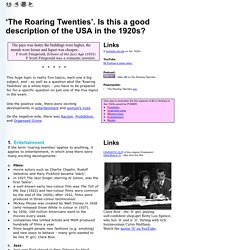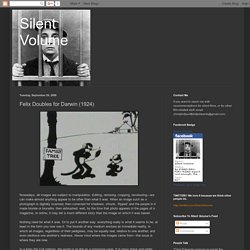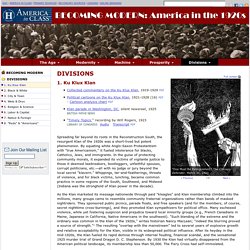

Timeline. Why the 2010s Are Reminiscent of the 1920s. In the wake of the terrorist mass murders in Paris and then San Bernardino, many Republicans and conservatives, already concerned about unauthorized immigrants from Mexico and Central America, have responded by conflating opposition to immigration, anxieties about the porousness of America’s borders, and fear of radical, Muslim-identified terrorists.

Most Republican governors (and Democratic Governor Maggie Hassan of New Hampshire) announced that they would refuse to accept refugees from Syria. Republican members of Congress, with the support of 25 percent of the Democratic caucus, passed a bill to “pause” the program. First, the Republican presidential candidate Donald Trump said he would “consider” closing Muslim mosques in the United States “because some of the ideas and some of the hatred—the absolute hatred—is coming from these areas.”
Trump then further suggested that Muslims should be required to have a special ID and promising to “bomb the shit” out of ISIS. America5. 3.

Race Relations How far were the 1920s a time of racism and discrimination for Black Americans? Argument 1 - A time of racism [HACKLE]: a. Hostility to immigrants: and the Red Scare' - see this page for more information. d. C. B. E. F. Argument 2 - A time of flowering [RHINO]: a. B. C. Someone Is Going Short Of Christmas Spirits! (1932) The Dodgers! A Prohibition Sidelight From Buffalo. Felix doubles for Darwin (1923) Felix Doubles for Darwin (1924) Nowadays, all images are subject to manipulation.

Editing, remixing, cropping, recolouring—we can make almost anything appear to be other than what it was. When an image such as a photograph is digitally scanned, then corrected for shadows, shrunk, ‘flipped’ and the people in it made blonde or brunette, then airbrushed; well, by the time that photo appears in the pages of a magazine, or online, it may tell a much different story than the image on which it was based.
Nothing need be what it was. Or to put it another way: everything really is what it seems to be, at least in the form you now see it. The bounds of any medium enclose an immediate reality, in which all images, regardless of their pedigrees, may be equally real, relative to one another, and even reinforce one another’s realness. In a Felix the Cat cartoon, the world is as flat as a magazine page. Believe it or not, this makes Felix a delight. Felix is soundless, but he does speak. 40,000 Ku Klux. Ku Klux Klan, America in the 1920s, Primary Sources for Teachers, America in Class, National Humanities Center.
"One Must Be Extinguished," The Chicago Defender, March 31, 1923 1.

Ku Klux Klan Spreading far beyond its roots in the Reconstruction South, the resurgent Klan of the 1920s was a short-lived but potent phenomenon. By equating white Anglo-Saxon Protestantism with "true Americanism," it fueled intolerance for blacks, Catholics, Jews, and immigrants. In the guise of protecting community morals, it expanded its victims of vigilante justice to those it deemed lawbreakers, bootleggers, unfaithful spouses, corrupt politicians, etc. As the Klan marketed its message nationwide through paid "kleagles" and Klan membership climbed into the millions, many groups came to resemble community fraternal organizations rather than bands of masked nightriders.
Collected commentary on the Ku Klux Klan. Political cartoons on the Ku Klux Klan. See also Black & White, Native & Foreign, and "Reds" & "Americans. " Discussion Questions Framing Questions. Native & Foreign, America in the 1920s, Primary Sources for Teachers, America in Class, National Humanities Center. ID certificate of Anna May Wong, issued at Seattle, 1924 7.

Native & Foreign Collected commentary on immigration restriction, 1921-1932 PDF Political cartoons on immigration restriction, 1919-1924 (5) PDF- Cartoon analysis chart PDF Inextricably linked in the Twenties' discussion of immigration, which led to the 1921 Emergency Quota Act and the 1924 Immigration Restriction Act, were the postwar issues of national identity and "Americanism," heated by the growing support for eugenics and racial purity theories. Collected commentary. Immigration to the US - , 1789-1930. 1920's Business and Economy. Fueled by easy money the nineteen-twenties were boom times like never before.

The post-war recession was forgotten as everyone went on a spending spree. Credit, and not savings, enabled consumers to boost corporate profits to new levels. The 1920's saw new discoveries and inventions in nearly every field of endeavor that became the foundation of thriving businesses. Patent attorneys did a roaring trade and nearly every man fancied himself as an inventor if the number of patent submissions was anything to go by. New business and production methods along with progressive business philosophies allowed manufacturers to boost turnover and to make large profits which they plowed back into new factories and wage rises. Increased incomes, along with the introduction of credit funded a huge increase in consumer spending.
There was an economic recession in 1921 but it was allowed to run its course without political interference and as a result it was over in 18 months. In April 1913 Pres. GCSE Bitesize: Why was there so much racial inequality in the USA between 1929 and 1945?